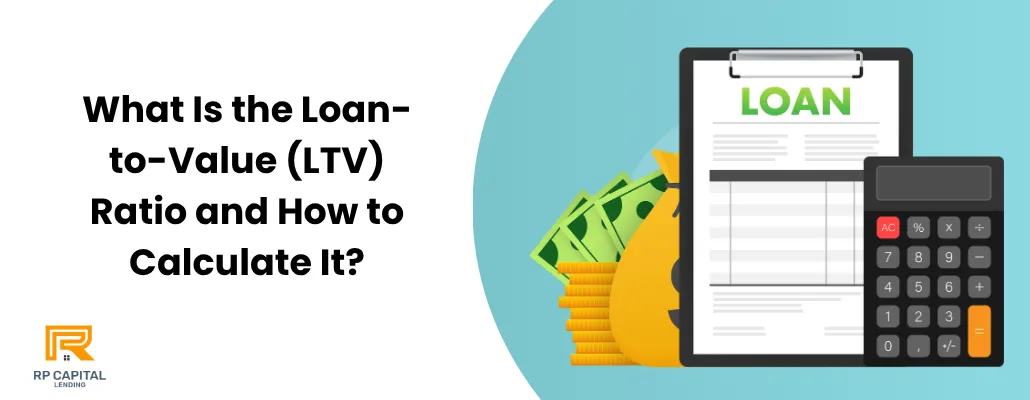Blog

What Is the Loan-to-Value (LTV) Ratio and How to Calculate It?
Welcome to our in-depth guide on the Loan-to-Value (LTV) ratio! At RP Capital Lending, we believe that knowledge is empowering, especially when it comes to financial decisions like securing a mortgage. Whether you’re a first-time buyer or looking to refinance, this comprehensive guide will walk you through everything you need to know about the LTV ratio, its significance, and how it can impact your borrowing experience. Let’s dive in!
Introduction to LTV Ratio
Definition
The Loan-to-Value (LTV) ratio is a vital financial metric that lenders use to assess the risk involved in offering you a mortgage. This ratio compares the amount of the loan you are seeking to the appraised value of the property you wish to purchase or refinance. Specifically, it helps lenders understand how much equity you have in the property versus how much you are borrowing.
In simpler terms, the LTV ratio tells lenders how much skin you have in the game when it comes to your investment. A lower LTV ratio indicates that you are investing more of your own money into the property, which typically reduces risk for lenders.
Read More: Loan To Cost vs. Loan To Value: A Detailed Comparison for Real Estate
Purpose
The primary purpose of the LTV ratio is to help lenders evaluate the level of risk associated with a mortgage application. If you're borrowing a significant chunk of money relative to the property's value, lenders may see that as a higher risk, which can affect their lending decisions. A high LTV ratio might signal the need for greater caution, while a lower ratio can indicate that you are a more reliable borrower.
Implications
Understanding how the LTV ratio affects your mortgage can be incredibly important. Here are some key implications:
Higher LTV Ratios: If your LTV is higher, typically above 80%, lenders may require you to pay private mortgage insurance (PMI), which protects the lender in case you default on the loan.
Lower LTV Ratios: A lower LTV ratio generally offers you better loan terms, such as lower interest rates and reduced fees. This can save you significant money over the life of your mortgage, making it crucial to strategize for a strong LTV ratio.
How to Calculate the LTV Ratio
Formula
Calculating the LTV ratio is a straightforward process that requires only two pieces of information: the loan amount and the appraised value of the property. The basic formula is:
LTV Ratio = Loan Amount / Appraised Property Value
Example
Let’s illustrate this with a practical example. Suppose you want to buy a charming home with an appraised value of $200,000 and you’re applying for a loan of $160,000. Plugging these values into our formula gives us: LTV=160,000 / 200,000=0.80 or 80%. This means you're financing 80% of the property's value. It's important to note that an LTV ratio of 80% is often considered favorable, while anything above that may raise red flags for lenders, potentially impacting your loan terms.
Understanding the LTV Ratio
Significance in Mortgage Underwriting
The LTV ratio plays an essential role in the underwriting process, where lenders assess the risk associated with each mortgage application. When you apply for a mortgage—whether for purchasing a new home, refinancing an existing one, or securing a home equity loan—your LTV will be scrutinized closely.
Lenders use this metric to gauge whether you can manage your loan repayment responsibilities effectively. For example, in a robust housing market, where property values are rising, a higher LTV ratio may still be acceptable. However, in a declining market, lenders may become more cautious about approving loans with high LTV ratios.
Risk Assessment
Understanding risk assessment in relation to the LTV ratio is critical. A higher LTV ratio may trigger the need for PMI, which serves as a safety blanket for lenders. Here's how it typically works:
Private Mortgage Insurance (PMI): If your LTV exceeds 80%, you may be required to obtain PMI, which can add a monthly cost to your mortgage payment. This insurance protects the lender if you default on your loan, ultimately increasing your overall borrowing costs.
Loan Conditions: In addition to requiring PMI, lenders may impose stricter terms for high LTV loans, such as higher interest rates, lower loan amounts, or additional documentation requirements. This is an important consideration as you prepare for your mortgage application.
Read More: Loan-to-Cost Ratio in Fix and Flip Investments
LTV Ratio in Practice
Typical LTV Thresholds
Most lenders today typically prefer to see an LTV ratio of 80% or lower. This means that borrowers are expected to make a down payment of at least 20% of the property's appraised value. Here’s how it breaks down:
LTV at 80% or below: Generally considered ideal. This range often allows borrowers to avoid PMI, minimizing monthly payments.
LTV above 80%: If your LTV surpasses 80%, you may face additional requirements, including PMI, which can increase your monthly expenses. It's worth considering how much of a down payment you can afford when planning to maximize your LTV ratio.
Impact on Borrowers
The LTV ratio significantly influences the overall mortgage experience for borrowers. Here are a few ways it affects you:
Lower LTV Ratios: Borrowers with LTV ratios of 80% or lower can often secure better loan terms, including lower interest rates, reduced fees, and more flexible repayment options. This can equate to thousands of dollars in savings over the life of the loan, making it worthwhile to strategize for a down payment.
Higher LTV Ratios: For those with higher LTV ratios, options may be limited, and costs can be steep. You might find it harder to qualify for certain types of loans, and you will likely face higher costs due to PMI and elevated interest rates. Higher borrowing can be tempting, but remember the long-term financial implications.
Variations on LTV Ratio Rules
Different Loan Programs
It's crucial to understand that not all loan programs treat LTV ratios the same way. Several government-backed programs allow for higher LTV ratios, which can be a lifesaver for many potential homeowners:
FHA Loans: The Federal Housing Administration often allows for LTV ratios as high as 96.5%. This is particularly beneficial for first-time buyers with limited savings.
VA Loans: The Department of Veterans Affairs provides loans that may not require PMI at all, even with high LTVs, making them an attractive option for eligible veterans.
USDA Loans: The U.S. Department of Agriculture also offers loans with high LTV ratios for qualifying borrowers in rural areas.
Adjustments Based on Creditworthiness
Your credit profile can significantly influence your ability to secure loans with high LTV ratios. If you have a strong credit score and a solid financial history, you might be able to qualify for loans with higher LTV ratios. Here’s how:
Flexibility for Strong Borrowers: Lenders may offer more favorable terms to borrowers with excellent credit, potentially allowing for higher financing percentages without the need for PMI or stricter conditions.
Impact on Loan Approval: If your credit is less than stellar, expect more scrutiny regarding LTV ratios. Lenders may require a lower LTV to mitigate risk, influencing loan availability and terms.
LTV vs. Combined Loan-to-Value (CLTV) Ratio
CLTV Definition
While the LTV ratio is a key metric for assessing risk, the Combined Loan-to-Value (CLTV) ratio is equally important, especially if you have multiple loans secured by the same property. CLTV considers all existing secured loans, not just the primary mortgage.
Comparison
Understanding the difference between LTV and CLTV is crucial for managing your overall debt:
LTV: This focuses solely on one loan and evaluates how much of the property’s value is financed by that loan.
CLTV: This takes a more comprehensive approach, considering all debts secured by the asset. For example, if you have a first mortgage and a home equity line of credit (HELOC), CLTV combines both to assess your total risk level. A high CLTV ratio can indicate greater financial stress, prompting lenders to impose stricter terms.
Read More: Demystifying Loan-to-Value (LTV) Ratio in Hard Money Lending
Conclusion
Importance of LTV Ratio
To wrap things up, the Loan-to-Value ratio is an essential element in the mortgage lending landscape. Its implications are far-reaching, affecting not only your loan approval odds but also the terms and costs associated with your mortgage. By understanding your LTV ratio, you empower yourself to make more informed and strategic financial decisions.
Strategic Considerations
As you embark on your borrowing journey, aim for a lower LTV ratio whenever possible. This approach can secure you better loan conditions, lower rates, and, ultimately, save you money over the long haul.
At RP Capital Lending, we are dedicated to helping our clients navigate the complexities of mortgage lending with confidence. We’re here to provide you with the guidance and insights you need to achieve your homeownership goals effectively.
Thank you for taking the time to read this comprehensive guide! Remember, whether you’re making your first investment in a home or considering refinancing, understanding your LTV ratio is crucial to ensuring a smooth and successful mortgage experience. If you have any questions or would like personalized assistance, don’t hesitate to reach out. We’re here to help you every step of the way!
FAQs About Loan-to-Value (LTV) Ratio
1. What is a good LTV ratio for a mortgage?
A good LTV ratio is typically considered to be 80% or lower. This means you are making a down payment of at least 20%. An LTV below 80% often allows you to avoid private mortgage insurance (PMI) and can lead to better loan terms and lower interest rates.
2. How does a high LTV ratio affect my mortgage rates?
A high LTV ratio, usually above 80%, indicates higher risk for lenders. As a result, borrowers may face higher interest rates and additional costs, such as mandatory PMI, making loans more expensive over time. Lenders might also impose stricter terms on loans with high LTV ratios.
3. Can I still get a mortgage with a high LTV ratio?
Yes, you can still secure a mortgage with a high LTV ratio, but it may come with conditions. Many lenders permit LTV ratios up to 95% or even higher in certain cases, particularly through government-backed programs like FHA or VA loans. However, be prepared for additional costs and possibly higher interest rates.
4. What is private mortgage insurance (PMI), and do I need it?
PMI is a type of insurance that protects lenders against losses if a borrower defaults on a loan with a high LTV ratio, usually above 80%. If your loan has an LTV exceeding this threshold, you may be required to purchase PMI to secure your mortgage.
5. How can I lower my LTV ratio?
You can lower your LTV ratio in a few ways:
Make a Larger Down Payment: Putting more money down reduces the loan amount relative to the property value.
Increase Property Value: Improving the property's value can enhance your equity position, thus lowering your LTV ratio.
Pay Down the Loan Balance: Making extra payments on your mortgage reduces your loan balance over time, contributing to a lower LTV ratio.
RP Capital Lending is a d.b.a of RP Capital Partners Inc (NMLS # 2469193) | Privacy Policy
Copyright © 2022. All Rights Reserved.
Disclaimer: Loans only apply to non-owner occupied properties. Rates, terms and conditions offered only to qualified borrowers, may vary upon loan product, deal structure, other applicable considerations, and are subject to change at any time without notice.

